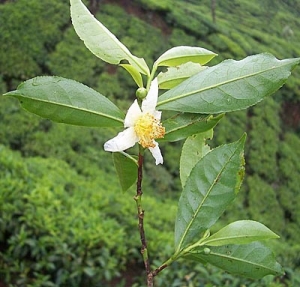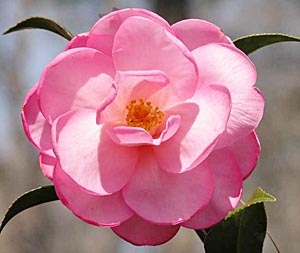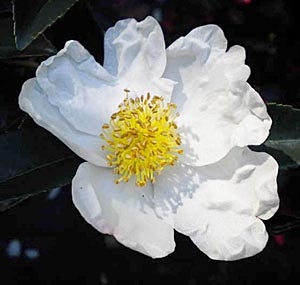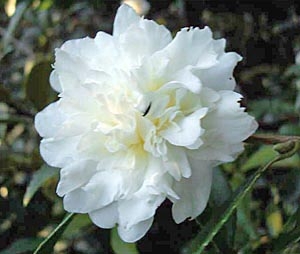Are Camellias Your Cup of Tea?
By Gil Medeiros, Fairfax Master Gardener
It’s a trick question. If you drink tea, the answer is yes; you are consuming an extract of Camellia sinensis leaves. If you don’t care about tea but want to improve your landscape, camellias are a good choice — possibly, your cup of tea.

Camellia sinensis
Camellia sinensis is an attractive-looking, evergreen shrub with modest flowers. Be advised, however, that it is not a good choice for Northern Virginia. It does well in South Carolina but not here. Plant breeders have been hard at work to give you something better: beautiful camellias that are hardy in this area and flower profusely.
The late Dr. William Ackerman of the National Arboretum was responsible for many of the hardy camellia varieties that we enjoy in the Middle Atlantic today. In the 1970s, Ackerman was working to breed camellias with more fragrant flowers; but in 1977-1978 we experienced very bitter winter weather here. By the spring of 1978, only 15 of 956 specimens at the National Arboretum survived. Ackerman had a new mission. He set out to breed more hardy camellias — based in part on hybrids from the shrubs that survived the brutal winters — and he was successful. In 1991, he released the famous “Winter Series” composed of hybrids of C. sasanqua, C. oleifera. C. heimalis and C. vernalis.
Many cultivars and hybrids of Camellia japonica and Camellia sasanqua are handsome, slow-growing, evergreen shrubs that thrive in Fairfax County. Some produce spectacular, rose-like flowers when almost nothing else is in bloom from October through December or from late February through March, depending on the species. These camellias are reliably hardy in zone 7. They like part shade. It is probably a good idea to give them shelter to protect from desiccating winter winds. However, I have six camellias that survived the two polar vortex winters. The wicked winds that damaged hollies in my yard did nothing to the camellias.
Camellia japonica may reach 12 to 25 feet in height and 10 feet in width. Camelia sasanqua, a more recent addition to the retail trade, will grow to a maximum of 6 to 8 feet tall but may achieve 8 to 10 feet across.
| Here are three cultivars that have done well in my yard.
Camellia japonica ‘Taylor’s perfection’ Camellia sasanqua ‘Survivor’ Camellia sasanqua ‘Snow flurry’ To learn more about camellia care, I recently attended a lecture given by noted camellia expert, Dr. Robert Bowden, at the Harry J. Leu Gardens in Orlando, Fla. The Leu Gardens contain the third largest collection of camellias in North America. (If you visit Orlando and can break away from the theme parks for a day, tour the Leu Gardens. You won’t regret it.) Bowden’s message was that camellias are easy to grow as long as you stick to a few basic principles. Here are some tips on camellia care from Bowden’s lecture: |
 Camellia japonica ‘Taylor’s perfection’  Camelia sasanqua x oleifera ‘Survivor’  Camellia x sasanqua ‘Snow flurry’ |
1. Sun is OK; drought is not.
Bowden’s team at the Leu Gardens had come to believe that shade was a necessary condition for happy camellias. As fate would have it, Hurricane Charley in 2004 toppled 200 huge laurel oaks at Leu Gardens, removing the shade conditions that prevailed for decades. After cleaning up the mess, Bowden and his camellia experts worked on a plan to restore the shady conditions they believed necessary for camellia health. But the gardens had no money to pay for any of the solutions. So they did nothing and waited sadly for the inevitable demise of the camellia collection, one of the jewels of the gardens.
Scientific discovery does not always conform to plan; sometimes it happens by accident. To the surprise of the scientists, the camellias grew better than ever and actually thrived in the sunnier conditions — all but one camellia, that is. After investigation, the Leu staff determined that this one did not receive adequate water because the fallen trees had damaged the sprinkler system. So the experts at the Leu Gardens learned that camellias can actually tolerate a lot of sun, but they cannot tolerate lack of water.
Plant your camellias in part sun to part shade. C. japonica likes dappled shade; C. sasanqua likes more sun. During periods of hot, dry weather provide plenty of water. Bowden recommends that the surface under camellias be mulched with pine straw or shredded bark to keep the soil moist and cool.
2. Fertilize regularly.
Bowden recommends that camellias be fertilized with Holly Tone several times per year. (Holly Tone is a good choice because it is acidic. Camellias like a pH between 6 and 6.5.) Some geographic calibration is required here because Bowden was lecturing to an audience in Central Florida, where soil is sandy and does not retain nutrients. In Fairfax County, where our soil is much heavier, one fertilization in the spring should be sufficient.
3. Prune judiciously.
According to Bowden, camellias should be pruned like any shrub. Diseased and damaged branches should be removed immediately. Once a year after the shrub has flowered, it can be shaped; crossing branches should be removed using thinning cuts. When the shrub is young, the center should be opened up, again using thinning cuts. This will promote air circulation and sun penetration to the interior of the plant.
Under no circumstances should camellias be sheared as hedges. Disease is not generally a problem with camellias unless they are trimmed into hedge form. The many wounds leave entry places for various diseases.
4. Keep pests at bay.
Camellias are visited by various scale insects. Bowden’s advice is to maintain the health of the camellias though proper siting, watering, fertilization and mulching. He says insects seldom attack camellias that receive proper care.
If you find cottony deposits on leaves or stems of your camellias, it is likely a scale insect infestation. Scale insects are tricky to control. Bring a sample to a Fairfax Couny Master Gardener Association plant clinic (May through September) near you or call the help line (703-324-8556). The master gardeners will diagnose the problem and recommend a solution.
Camellias are great as screening or specimen plants in Fairfax landscapes. They are not difficult to grow. They might just be your cup of tea.
References
Camellias for Texas Gardens, William C. Welch
A Life with Camellias, Adrian Higgins, Washington Post, July 24, 2013
Camellia Hybrida Winter Series, North Caroline State University Cooperative Extension
Camellia Sinensis, North Caroline State University Cooperative Extension
Camellia japonica, North Caroline State University Extension
Sasanqua: The Other Camellia, North Carolina State University Extension
History of South Carolina Tea Farms, South Carolina’s Information Highway